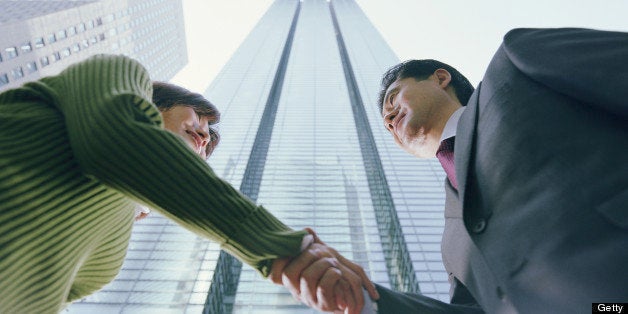
When Heather began her career as a literary agent, she'd often greet her clients much as she would her friends: with a loose hug or a quick kiss on the cheek. She did not discriminate with her affections; it didn't matter if the client was a much older gentleman or a woman around her age. And though she was a naturally affectionate person, she administered these greetings with actual professional purpose: "A hug or a cheek kiss always seemed to be a way to foster intimacy and connection, whereas a handshake was so formal and cold," she said. "I thought a more familiar approach would help us establish closeness and trust" -- vital, she thought, to the agent-writer relationship.
But over the years, Heather began to wonder if this hyper-familiarity might in some way undermine how these clients saw her. Did it make her seem childish? Too girly? Was she subconsciously using these greetings as flirtations? Her male colleagues certainly didn't embrace their female clients nearly as freely, especially not the older ones, and they seemed to establish trusting relationships just fine.
Though it's not entirely accurate to say that women are more affectionate than men, according to Gallup polls, that stereotype still prevails in the minds of most Americans. And indeed many women -- and men -- do embrace the professional embrace, hugging clients or colleagues in place of the traditional handshake. This is especially true as the American workplace has grown more casual. At the same time, working women are consistently coached in how to act "less girly," and more "like men" in order to get ahead. Included among the advice: Handshake, not hug.
In Lean In, as Facebook COO Sheryl Sandberg encourages women to fight against unfair double standards, the message, in many places, appears to be that downplaying femininity is a good idea for those looking to be taken seriously. "Leaning in" includes being direct and voicing opinions. It also includes giving a firm handshake. This is, after all, how the men do it.
Still, there is proof that handshakes can be an effective way of forging a bond. A December 2012 study published in the Journal of Cognitive Neuroscience reported that a firm handshake increases the likelihood of a positive reaction, while diminishing the likelihood of a negative reaction. At the same time, there is also evidence, including from a 2010 study published in the journal Emotion that looked at the power of touch among teammates, that shows gentle or supportive touch can engender feelings of affection, help create a sensation of trust, and reduce levels of the stress hormone cortisol. The bottom line: Handshakes are effective, but hugs are, too.
When Lola began her new job as a department head at a custom publisher, she found that a quick hand on a staffer's shoulder or elbow made delivering criticism more palatable. "Establishing a physical connection made difficult conversations easier for me and, I believe, them," she told me. "I felt like I could see a difference in how information was received when I made it more personal, versus when I stood back, with folded arms, in a more 'professional' manner." Though she would never do so in the office, whenever she ran into staffers outside of work, she was quick to give a hug or kiss. At the same time, she often wondered if such affection coming from a male boss might have come across as creepy or condescending. "I was aware that, as a woman, this was a tool I could use," she said. "Did it make me any less serious, or effective, as a boss? I don't think so. If being female made this method of interacting more acceptable, I welcomed it -- with open arms, you could say!" Just because a hug wasn't something a man would, or could, do didn't mean Lola's use of such affection diminished her effectiveness as a leader.
Which brings us to the real issue here: That is, challenging the idea that women need to behave more like men in order to get respect in the workplace, or make professional gains. Workplace style is entirely individual, and every female action needn't be compared to its male counterpart. Women are women, men are men, and everyone's different regardless of gender.
And just as the male workplace style shouldn't be considered the superior one, the female-administered workplace hug or kiss isn't right for everyone. Jenna, an investment banker, did not like to kiss, or be kissed by, clients, but found that avoiding doing so made her seem uptight and unfriendly. "I used to step backwards if I saw a hug or cheek kiss coming, trying to be subtle, but it was clear that this only offended people," she said. "But I felt so awkward with the closeness." Instead, she practiced being warmer with her handshakes, so that those clients who expected more familiarity received it, while Jenna was able to stay true to herself.
Striving for gender equality both in and out of the workplace doesn't mean women should be striving to emulate, "overtake," or actually be men. Whatever women choose to do -- hug, kiss, handshake -- it's key to embrace the choice and approach the movement with confidence and ease. In the end, it's less about the point of contact than about the attitude behind it.